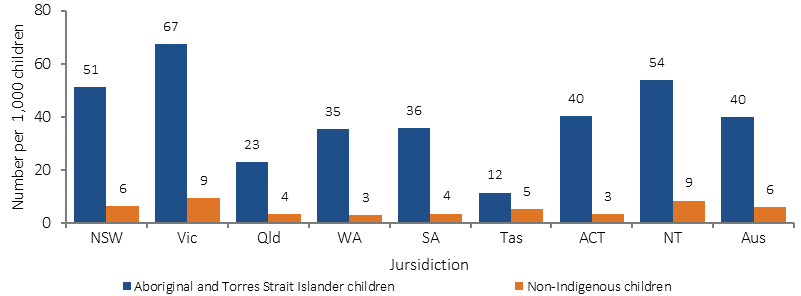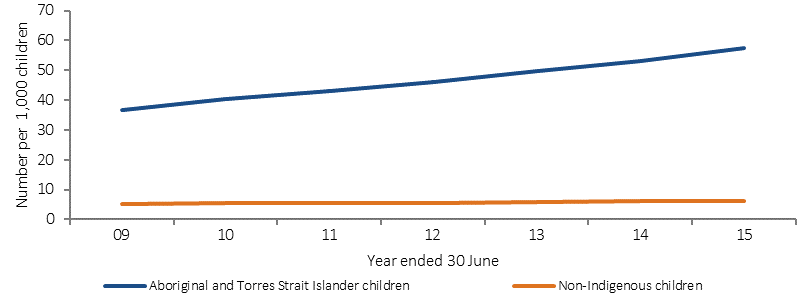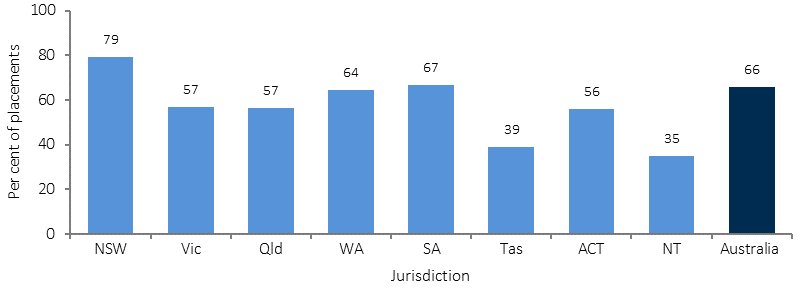2.12 Child protection
Page content
Why is it important?
Experience of maltreatment (physical, emotional and psychological abuse, neglect, sexual abuse and witnessing family violence) during childhood has serious and long-term impacts on social and emotional wellbeing and health (Emerson et al, 2015). Exposure to trauma, neglect and experience of out-of-home care is associated with suicidal behaviour (Atkinson, 2013; Robinson, G et al, 2011). Contact with the criminal justice system increases the risk of experiencing family violence as an adult (Guthridge et al, 2014; Wong, J & Mellor, 2014).
All jurisdictions have legislative requirements on the mandatory reporting of suspected child abuse. Child protection functions are undertaken at the state and territory level of government. Each jurisdiction has its own legislation, policies and practices in relation to child protection (Guthridge et al, 2014; AIHW, 2016z; 2016v).
Indigenous Australians’ experience of child welfare policies has historically been traumatic, with the policy of forcible removal of children known as the Stolen Generations (National Inquiry into the Separation of Aboriginal and Torres Strait Islander Children from Their Families, 1997). The consequences of these removal policies have long-term impacts, including social, physical and psychological impacts for those directly involved, as well as their families and communities (Atkinson, 2013). Child protection issues continue to be very significant for Indigenous communities, reflecting this history of trauma and stressors that have impacted on parents, parenting skills and communities. Issues such as substance abuse, poverty and family violence are also key factors (AHRC, 2015; de Bortoli et al, 2015).
In responding to situations in which Indigenous children are at risk, all states and territories have adopted the Aboriginal and Torres Strait Islander Placement Principle that requires that where Aboriginal and Torres Strait Islander children are removed from their family, the following order of preference for their placement should be followed: the child’s extended family; the child’s Indigenous community; other Indigenous Australians. Barriers to this principle include a shortage of foster and kinship carers, issues of support for kinship carers and inconsistency in child protection decision making (Arney et al, 2015; Kiraly & Humphreys, 2016).
Findings
In 2014–15 there were 11,675 Indigenous children who were the subject of substantiated child protection notifications. For Indigenous children aged 0–17 years, the rate was 40 per 1,000, or 6.7 times the rate for non-Indigenous children (6 per 1,000). Rates of children who were the subject of substantiations of notifications vary across jurisdictions, in part reflecting different legislation, policy and practices in each jurisdiction (AIHW, 2016z). While comparisons between jurisdictions should be made with care, rates of Indigenous children who were the subject of substantiations were higher than for non-Indigenous children within each jurisdiction (ranging from 2 times to 12 times). Nationally the most common reasons for substantiated child protection notifications for Aboriginal and Torres Strait Islander children aged 0–17 years were neglect and emotional abuse (both 38%) compared with 21% and 46% of substantiations respectively for non-Indigenous children. Across the majority of jurisdictions sexual abuse was the least common type of substantiation for Indigenous children (9% nationally compared with 14% for non-Indigenous children).
Nationally, between 2008–09 and 2014–15, there was an increase in the rate of children who were the subject of child protection substantiations, with Indigenous rates increasing from 29.3 to 39.8 per 1,000, and non-Indigenous rates increasing from 5.2 to 5.9 per 1,000.
As at 30 June 2015, there were 16,922 Aboriginal and Torres Strait Islander children on care and protection orders. This represents an increase from 30 June 2009 (36.6 to 57.5 per 1,000), while the non-Indigenous rate has slightly increased (5.3 to 6.3 per 1,000).
As at 30 June 2015, there were 15,455 Indigenous children in out-of-home care. Indigenous children were 9.5 times as likely as non-Indigenous children to be receiving out-of-home care (52.5 per 1,000 compared with 5.5 per 1,000). Across Australia, 66% of Indigenous children in out-of-home care were placed with either a relative/kin or an Indigenous carer or in other Indigenous care. Placements with relative/kin or an Indigenous carer were highest in NSW (79%) and lowest in the Northern Territory (35%). In 2015, 45% of 15–17 year old indigenous children in out-of-home care indicated they received inadequate assistance or require more assistance staying in touch with culture/religion (compared with 38% non-Indigenous children) (AIHW, 2016s).
Young Indigenous people aged 10–17 years who were in the child protection system in 2014–15 were more likely to be under youth justice supervision at some time in the same year: 14% of Indigenous males and 7% of Indigenous females compared with 6% of non-Indigenous males and 2% of non-Indigenous females (Malvaso et al, 2017; AIHW, 2016v).
In NSW prisons nearly half of all Aboriginal inmates were placed in care as children, twice the non-Indigenous rate. Aboriginal inmates were also more likely to report their parents had been placed in care as a child (27% of women and 14% of men) (Indig & Wales, 2010).
Figures
Figure 2.12-1
Children aged 0–17 years who were the subject of a substantiation: no. per 1,000 children, by Indigenous status and jurisdiction, 2014–15

Source: AIHW Child Protection Collection 2015
Figure 2.12-2
Children aged 0–17 years on care and protection orders: no. per 1,000, by Indigenous status, 30 June 2009 to 30 June 2015

Source: AIHW Child Protection Collection 2015
Table 2.12-1
Children (0–17 years) in out-of-home care, by Indigenous status and jurisdiction, 30 June 2015
| NSW | Vic | Qld | WA | SA | Tas | ACT | NT | Australia | |
|---|---|---|---|---|---|---|---|---|---|
| Number of Children | |||||||||
| Indigenous | 6,210 | 1,511 | 3,512 | 2,062 | 844 | 241 | 183 | 892 | 15,455 |
| Non-Indigenous | 10,631 | 7,049 | 4,879 | 1,890 | 1,949 | 812 | 482 | 125 | 27,817 |
| Total(a) | 16,843 | 8,567 | 8,448 | 3,954 | 2,838 | 1,061 | 671 | 1,017 | 43,399 |
| Rate per 1,000 children | |||||||||
| Indigenous | 67.4 | 71.5 | 40.0 | 55.3 | 52.3 | 22.5 | 74.8 | 33.4 | 52.5 |
| Non-Indigenous | 6.6 | 5.5 | 4.7 | 3.4 | 5.7 | 7.9 | 5.7 | 3.4 | 5.5 |
| Total(a) | 9.9 | 6.6 | 7.5 | 6.7 | 7.9 | 9.3 | 7.7 | 16.0 | 8.1 |
| Rate ratio | 10.2 | 12.9 | 8.5 | 16.3 | 9.2 | 2.9 | 13.1 | 9.8 | 9.5 |
(a) Includes Indigenous status not known
Source: AIHW Child Protection Collection 2015
Figure 2.12-3
Proportion of Indigenous child placements with relatives, kin or other Indigenous caregiver, by jurisdiction, 30 June 2015

Source: AIHW Child Protection Collection 2015
Implications
Child protection data provide a measure of how many children come into contact with child protection services; however, these data do not capture all children who have been abused or neglected and, additionally, may include some children who have not been abused or neglected (Bromfield & Higgins, 2004).
Aboriginal and Torres Strait Islander children continue to be subject to higher rates of child protection substantiations. There is a connection between higher rates of ‘neglect’ and lower socio-economic status, alcohol and substance abuse and malnutrition or ‘failure to thrive’ (AHRC, 2015). Family violence is often categorised as ‘emotional abuse’. A recent Inquiry in Victoria has found that family violence, in combination with parental alcohol and/or drug abuse, is the leading cause for Aboriginal children’s entry into out-of-home care. Of the Aboriginal children reviewed, 88% were impacted by family violence and 87% were affected by a parent with alcohol or substance abuse issues (Commission for Children and Young People, 2016). This Inquiry also found that the child protection system had failed to preserve, promote and develop cultural safety and connection for Aboriginal children in out-of-home care.
COAG has two major commitments in the area of child protection: The National Framework for Protecting Australia’s Children 2009–2020 (COAG 2009) and the National Plan for Australia to Reduce Violence Against Women and their Children 2010–2022. These commitments recognise that everyone has a right to be free and safe from family violence and abuse and that breaking inter-generational cycles of maltreatment is best achieved by families, communities, community organisations and governments working as partners to build strong and resilient families.
In October 2016, the Australian Government committed $100 million to the Third Action Plan under the National Plan for Australia to Reduce Violence Against Women and their Children 2010–2022, including $25 million in funding for Indigenous specific activities to address family violence in Indigenous communities.
The Australian Government funds a number of initiatives through its Indigenous Advancement Strategy’s Safety and Wellbeing Programme designed to deliver a range of activities for Indigenous families whose children have come into contact with the child protection system or are at risk of coming into contact with the child protection system.
The Australian Government is providing $35.8 million over five years to the NT Government to deliver the Remote Family Support Service under the National Partnership on Northern Territory Remote Aboriginal Investment. This service will improve the delivery and coordination of child protection and family support services in remote areas.
The Australian Government also funds Indigenous Parenting Services that provide prevention and early intervention activities that support parents to address underlying issues that can present barriers to effective parenting, especially for children at risk of abuse and neglect. Further evaluation is required to assess the effectiveness of Indigenous parenting programmes and how well they attract and retain participants and the cultural competence of the service (Emerson et al, 2015) .